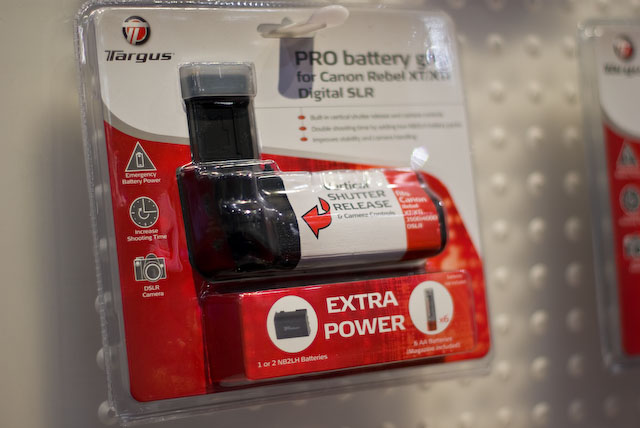PMA wrap-up
PMA 2009 is in the books. All in all it was a pretty lack-luster show for us enthusiasts. Following are a few more product findings, some observations and my conclusions about the show in general. Be sure to check out my Day 1 and Day 2 reports if you haven’t already.
Click through for the rest of my Day 3 report or click here for my complete PMA report.

Seahorse’s waterproof hard-sided equipment cases have all the features of the bigger brands at less than half the price. If and when I need one of these this will be the brand I’ll buy.

Hoya’s new HD filters promise to redifne the filter paradigm. I picked up a 77mm sample for testing. Unfortunately, I don’t presently have a lens with a 77mm element. I hear Pentax’s 16-50 f/2.8 DA* does…

Liquid Image’s scuba mask digital camera may look pretty retarded but it’s actually a one of the more clever ideas at the show. As a former certified scuba diver I can safely say that, unless underwater photography is your profession, a dedicated cost-effective solution like this makes a lot of sense. (Have you priced underwater DSLR housings lately?) The hands-free design is quite ingenious for sport divers as it eleimnates the usual fumbling with underwater cases. I get the idea behind the mask-mounted lights, but if it were me I’d pass on them and just carry an old fashioned hand-held dive light for those deep water shots.

Note to Tamrac: hire a design firm. Your bags are u-g-l-y!

“So you won’t look like a tourist.” I’m told that this OP/TECH neoprene camera cover is easy-on/easy-off. This looks to me like some kind of combination ED and S&M/bondage product.

(no comment)

Ladies, why confine your scrapbooking to dusty old books destined for life on a bookshelf? Why not carry your photos with you proudly displayed for everyone to see? Actually, now that I think of it, Braggables might be on to something. Louis Vuitton has got nothing on my girls.

Dust-Aid got a lot of attention for their new clear plastic film mirror box/sensor covers. I agree with them that their product could be an ideal solution for pros heading out on safari, but am skeptical about amateurs dropping $20 a pop for something this fragile.

A better $20 solution from Dust-Aid is their Dust-Aid Classic product. It features a special silicone pad that simply lifts dust off the sensor. This seems like such a better idea than just blowing dust around inside the mirror box where it’s likely to just end up back on the sensor.

By the way, Sigma has been sealing their mirror boxes for a while now. Why doesn’t anyone else do this?

Speaking of Sigma. Check out their 200-500 f/2.8 EX APO DG lens they had hiding around the side of their booth.

According to Sigma: “For the convenience of the photographer, focusing distances and focal lengths can be viewed on the lens’ built-in LCD panel.” That’s nice. Unfortunately, the $34,000 price tag does not include the stand needed to support this beast- you know, for the convenience of the photographer and all…

This bothers me somehow.

What exactly is it that Panasonic thinks we will be doing with their cameras?

I found it somewhat ironic that focus and zoom rings on Samsung’s versions of the Pentax lenses are a closer design match to Pentax’s old lenses than their new ones (old on the right, new in the middle and on the left):

In Conclusion:
The digital camera industry has reached a critical development point. Today’s cameras have made wonderful photography accessible to the masses. However, all the bells and whistles modern cameras now feature are making it harder for novice photographers to actually learn photography. It used to be that entry-level photographers would start off their learning experience with a fully manual 35mm SLR and then step up to more feature rich products as they developed their photographic skill and better understood how to make the most of the extra features. Today’s entry-level DSLRs have basically all the same features as the most advanced professional models. The problem is that, in an effort to make the entry-level cameras more approachable, even some of the most basic shooting settings are buried in a menu system and overridden by automatic settings. What has been lost is that critical connection between the photographer, the camera and the exposure triangle (aperture, shutter speed & ISO).
The result is that there are more and more people running around taking pictures with fancy cameras who have no idea why their pictures turn out the way they do. The problem is that they often quickly become frustrated when they realize there’s no creative preset for every type of picture they want to take. I have yet to see a “bokeh” preset for example. The solution that the camera industry seems to provide is new cameras with even more features. What I would like to see is the camera manufacturers use technology to build a camera with only the features that actually help people take better pictures while becoming better photographers. As an experienced product designer this is what I would do if given the chance:
- Put the aperture control ring back at the base of the lens but make it a “by wire” system that keeps the aperture open to maintain a bright viewfinder for composing the shot while providing feedback in the viewfinder. “A” setting provides automatic control.
- Dedicate a thumbwheel to shutter speed and index it so that it has dedicated and marked shutter speed stops like manual film cameras do. Again, provide digital feedback in the viewfinder and include an “A” setting.
- Dedicate a second dial to ISO control with similar feedback and an “A” setting. ISO range from 100 up to a usable 32,000 as seen on the the latest high end DSLRs.
- Include a front control dial dedicated to exposure compensation. Allow changes to steps and direction via the menu.
- Loose multi-point AF and just make the center focus point work damn well all the time.
- No built-in flash. Hot shoe mount only.
- Use the space saved by deleting the flash to make the viewfinder bigger, brighter and have 100% coverage.
- Dedicated on/off switch around the the shutter release button- not hidden on the back of the camera.
- In-body sensor shift image stabilization with auto-override for stabilized lenses.
- Simple multi-position switches for auto-focus and metering modes.
- Dedicated image review buttons (play, delete, zoom, info, navigation, etc.)
- Simplified menu structure- don’t waste space on things that don’t help take pictures like “slideshow” and “creative effects.”
- Include a dedicated B&W shooting mode (even for RAW). There’s something about knowing you’re shooting in B&W that causes you to look at composition differently.
- Maybe even make it a dedicated RAW format camera- sort of like shooting film you’re going to process yourself.
- Move the top-mounted LCD screen to a dedicated screen on the back (like Canon did on the original Digital Rebel) and don’t clutter up a whole 3″ LCD with graphics and too much information.
- Make it super responsive (menus, start-up, review, shutter lag, etc.) and fast (5+ frames per second).
- Wrap the whole thing in a mid-sized rugged metal weather sealed chassis.
- Include modular different sized rubber grip inserts to allow a custom fit to all hand sizes. Or perhaps you can go without a grip if you prefer.
- Price it all under $500 and bundle it with a 50mm f/1.8 (or faster) equivalent lens while making it compatible with all full frame and APS-C sized lenses offered by the manufacturer.
The interesting thing is that most of these features are already being done or have been done on one camera or another. Maybe if one of the big brands decides to follow my advice we’ll have something a bit more interesting to talk about next year. Something that reconnects the photographer with the camera and the whole photographic experience. Perhaps if I can find some free time I’ll mock-up a 3D CAD model to explore my ideas…

March 7th, 2009 at 9:14 pm
Happy to take the Hoya filter off your hands to save you from having to buy a new ø77 lens.
March 8th, 2009 at 5:24 am
Great wrap up. Almost makes me okay with me having missed this one. Here’s to hoping next year will be great.
Damien
March 8th, 2009 at 12:31 pm
@ Stephen: OK but I promised them a review on my blog. You up for a little writing?
@ Damien: Thanks! The show was a a bit slow. Of course, I’m used to shows like CES where there is MUCH more going on. Hopefully I’ll have a few more product reviews coming in the next few weeks as I am expecting some samples to be coming my way!